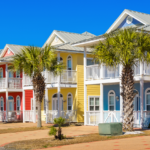If you’re the proud owner of a condominium, you know you own a little slice of heaven with a lot less lawn to mow. But there’s still a need to insure your condo. Although condo insurance is not unlike homeowners insurance and is undoubtedly more complex than renters insurance, it’s just right for the unique needs of condo owners.
First off, condo insurance is not as heavy-duty as homeowners insurance. You’re not insuring the whole shebang — your condo association typically takes care of the outer shell — the structure and property. But you’ll want to protect the part of the unit that’s your private space — the part you own from the walls on in, covering your furniture, electric gadgets, and all the stuff that makes your place feel like home sweet home.
Don’t get condominium insurance confused with renters insurance, either. Condo insurance goes above and beyond. While renters might fret over the newest X-Box or their latest IKEA haul, you’re looking to protect improvements you’ve made, like a bathroom makeover or your hardwood floors.
So, whether it’s a stolen laptop, a kitchen fire, or a burst pipe, condo insurance can swoop in and save the day so you can enjoy your little kingdom without worrying about unexpected disasters.
Here’s what’s included in a standard condo insurance policy
1 – DWELLING COVERAGE:
Dwelling coverage in your condo insurance helps you restore your condo to its original state following a covered loss. This coverage becomes essential in scenarios like fire, vandalism, or specific water damage incidents as it kicks in to handle repair or reconstruction costs. It encompasses structural elements such as walls, ceilings, floors, plumbing, electrical systems, built-in appliances, and fixtures.
- Did you know? States — like Florida and Texas — which are prone to natural disasters, often experience higher numbers of dwelling coverage claims. Hurricanes, floods, and tropical storms are frequent perils in these regions, making them more susceptible to claims related to structural damages.
2 – PERSONAL PROPERTY:
Personal property coverage in condo insurance protects things like furniture, clothing, and electronics within your home or on a patio or deck. But it also extends to items you take outside, like laptops and e-bikes. It’s important to be aware of coverage limits and create a detailed inventory with photos and estimated values. This will streamline the process if you ever need to make a claim.
- Did you know? Do you have valuable jewelry, artwork, or collectibles? Note that reimbursements on standard policies may have limits as low as $1,000, so consider additional coverage — often known as endorsements or floaters — to protect your high-value items. This extra coverage allows you to specify and insure belongings that may exceed the basic limits of your policy’s personal property coverage. Keep in mind that some areas known for higher crime rates, including property theft, may impact the insurance premium you’ll be asked to pay.
3 – LIABILITY COVERAGE:
Liability coverage is your safety net in case someone is injured while in your condo or if you accidentally damage someone else’s property. It also covers legal fees in case of a lawsuit related to covered incidents. Assessing personal liability risks is necessary to help you choose the appropriate coverage limits. If you’re a frequent host of parties, have an aggressive pet, or are always doing some home improvement project with tools, ladders and supplies lying that could cause someone to get hurt, think about ramping up protection a little.
- Did you know? In today’s litigious society, liability claims can extend beyond property issues. Libel and slander lawsuits have become more common, even for seemingly minor matters. That’s why it’s important for condo owners to understand that reputational attacks are not covered by liability protection in your condo insurance policy.
4 – LOSS OF USE:
Loss of use coverage is a lifesaver when your condo becomes uninhabitable due to a covered event — like a fire in the building or roof damage due to a hurricane. It not only helps with additional living expenses like hotel bills but also covers extras like food, transportation and storage costs for your belongings, ensuring you can maintain your standard of living during repairs.
- Did you know? Loss of use claims typically occur when a condo becomes uninhabitable due to covered events. Common scenarios include fire damage or significant structural issues. The number of claims may vary based on the prevalence of such events in the region.
5 – MEDICAL PAYMENTS:
Medical payment coverage takes care of the medical expenses for guests (or roommates) injured in your condo, no matter who’s at fault. It’s designed to quickly resolve minor injuries, skipping the whole legal battle process. Keep an eye on the coverage limit per person, making sure it aligns with potential medical costs. This coverage is not just about bills; it’s a handy tool for maintaining good relations with neighbors and guests.
- Did you know? While medical payment claims are relatively common for minor injuries that occur within a condo, they can also pay for some injuries that happen away from your condo unit, such as your dog biting someone in a local park.
Your handy condo insurance checklist!
Overall, most standard condo policies typically cover losses arising from:
- Fire and lightning
- Sudden and accidental damage by smoke
- Explosion
- Theft
- Vandalism and malicious mischief
- Damage due to aircraft and vehicles
- Wind storms or hail
- Sudden and accidental water damage
- Weight of ice, snow, or sleet
- Riot and civil commotion
But typical condo insurance usually won’t cover losses due to:
- Flooding, including a tidal surge, although flood insurance may be available in a different policy.
- Earthquakes, earth movement, landslides, mudslides, and sinkholes.
- Termites, insects, rats, mice, birds, bats, or other vermin.
- Freezing pipes if water was not shut off or the building was not heated.
- Certain losses if your condo is vacant for a specified number of days outlined by your policy.
- Wear and tear, rotting, maintenance, and pollution.
- Damage to trees and shrubs from wind or hail.
- Mold, unless it results from a covered loss (e.g., mold damage due to a flood would not be covered).
- Persistent and recurring seepage leading to water damage.
- Liability resulting from the ownership or use of a motorized vehicle, aircraft, or watercraft.
- Deliberate acts initiated by you or anyone living in your condo.
- War or nuclear hazard.
Let’s get you insured!
Condominium insurance functions like a homeowner’s policy, with the difference being that your unit is part of a larger building overseen by a condo association (that’s where your condo fees go). Understanding the inclusions and exclusions of both your personal condo policy and the HOA insurance is important, but it can take a lot of time and be confusing.
A conversation with a condo insurance expert at Guided Solutions can take the pressure off. We do the legwork for you, listen to your needs, compare policies, and come back with a condo policy that’s perfect for you.
Get started here or call (855) 701-2477 to speak with an advisor!










